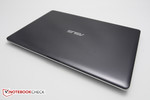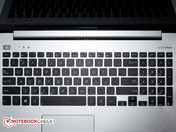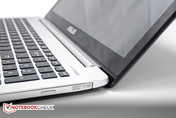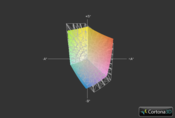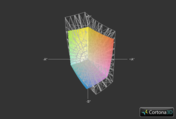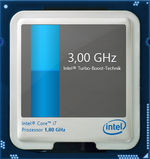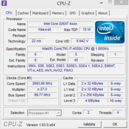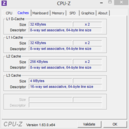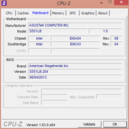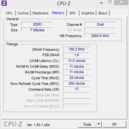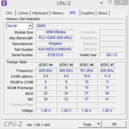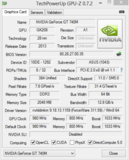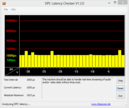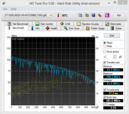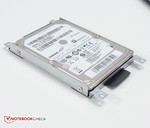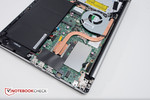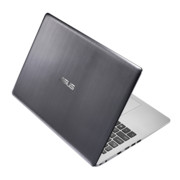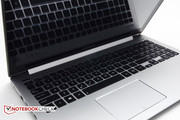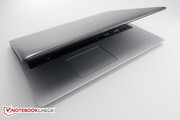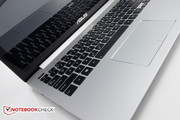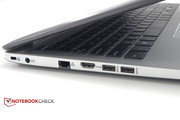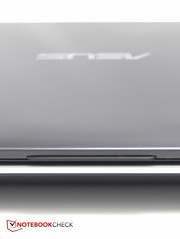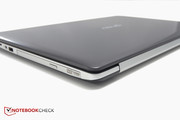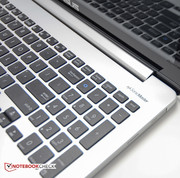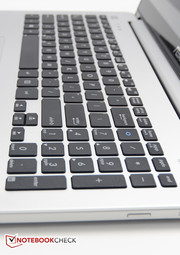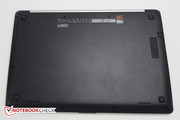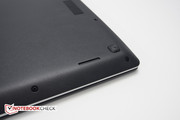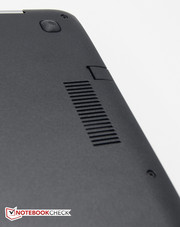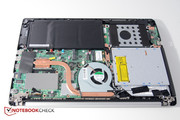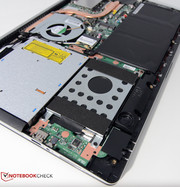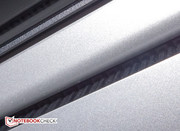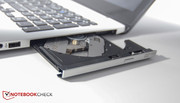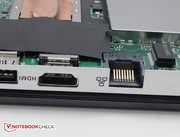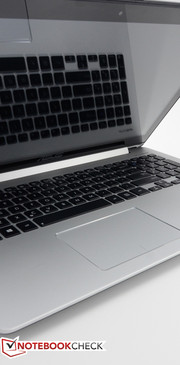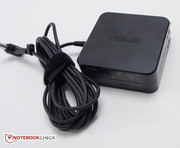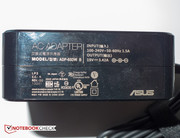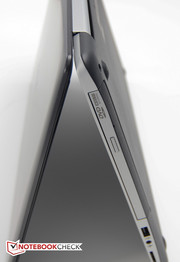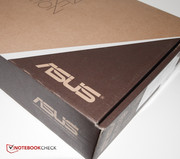Review Asus VivoBook V551LB-DB71T Ultrabook
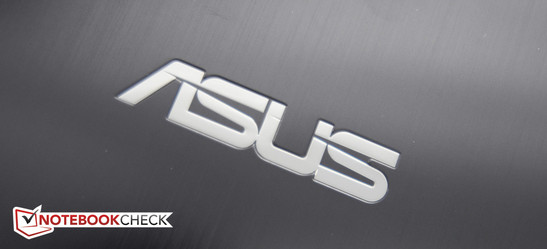
The number of larger 15-inch slim notebook designs on the market is increasing. Asus themselves offers a confusing selection: in addition to the high-end Zenbook UX51, the more mainstream VivoBook-series consists - in addition to 11.6 and 14-inch models - of no less than five 15.6-inch entries at the time of writing. The newest family member features a 4th generation (Haswell) low-voltage Intel Core i7-4500U processor, 8 GB DDR3 RAM, and a 1 TB conventional hard drive. Vivobooks have always been touch-enabled, so the 15.6-inch LED backlit HD (1366x768) panel conforms to Intel's revised Ultrabook specifications. A middle-tier Nvidia GeForce GT 740M graphics card rounds out the hardware selection. In Europe, Asus sells the nearly identical S551LB, which we reviewed last month. We will reference this model in our review whenever appropriate.
Since the segment of low-profile touchscreen notebooks is heavily contested, there are many potential alternatives both above and below the $1000 price tag of our review model. The budget-priced Acer Aspire V5-571P - although it is slightly too thick to carry the Ultrabook-moniker - comes with an Ivy-bridge Core i5 ULV processor and Intel HD Graphics 4000. A version with Core i3 CPU carries a street price of just above $500. Dell's Inspiron 15z Ultrabook Touch (see our review of the non-touch 15z 5523 here) starts at about $750 (integrated graphics). Asus also offers a version of the slightly thicker and more potent Asus N550JV with a Full-HD IPS panel, Haswell Intel Core i7-4700HQ CPU, and GeForce GT 750M for only about $100 more.
Case
With its very upscale-looking brushed metallic texture on the inside, single hinge design, and slim profile, the chassis of the VivoBook V551L borrows many traits of the high-end Zenbook UX51. The bottom of the Ultrabook consists of one solid piece of plastic with only a single cooling vent on one side and the openings for the speakers up front. Even though this is an Ultrabook per Intel's definition, it's best to keep in mind that the V551L is not small by any means - its actually larger than a Lenovo Thinkpad W530 workstation. While substantially slimmer, the Vivobook still weighs in at a hefty 2.49 kg, which can prove to be tiresome when lugging the system around for extended periods of time. Even the budget-priced Acer Aspire V5-571P comes in at around 100 grams less. For more details on the chassis, please check our review of the German VivoBook S551LB here.
Connectivity
The Ultrabook features a pretty standard array of ports. We appreciate the fact that the HDMI connector is on the left side of the notebook and behind the middle line, so the cable won't get into the way of an external mouse - even for lefthanded users. It's worth noting that the new Ultrabook is missing the VGA port, which was still available on the predecessor S550CM. For more details on the port selection and placement, as well as the built-in wired and wireless communication modules, accessories, and upgradeability, please check the appropriate sections in our review of the VivoBook S551LB.
Input Devices
Keyboard
The chiclet-style keyboard features the same overall design that is used for the European model. The layout is different though: the Enter key, for example, spans two rows on the S551LB and only a single row on the V551LB. The typing experience is generally pleasant. Worth mentioning is the blue key in the number pad section, which launches the Asus Console - a dedicated screen for several bundled Asus apps.
Touchpad
The touchpad features the same texture as the palm rest and is recessed slightly, so the edges can easily be felt when the fingers are moved across the surface. Contrary to our colleagues reviewing the S551LB, we didn't have significant issues with the sensitivity. Windows 8 edge swipes, as well as two and three-finger gestures, worked quite well.
Touchscreen
We also had no problems with the touchscreen, which responded instantly to swipes, zooming, and finger slides. Due to the weight of the base unit, the notebook remained firmly planted, even when we tapped the screen more vigorously.
Display
Asus equips the VivoBook V551LB with a glare-type panel from AU Optronics. Considering the price point of around $1000, we would have liked to see a higher resolution than 1366 x 768 pixels and the corresponding paltry pixel density of 100 DPI. To make matters worse, the screen is also pretty dim with an average brightness of just under 170 cd/m². The Aspire V5-571p is about 10 nits brighter, the IPS panel of the Asus N550JV reaches almost 280 nits.
| |||||||||||||||||||||||||
Brightness Distribution: 88 %
Center on Battery: 182 cd/m²
Contrast: 399:1 (Black: 0.457 cd/m²)
ΔE ColorChecker Calman: 5.97 | ∀{0.5-29.43 Ø4.78}
ΔE Greyscale Calman: 4.89 | ∀{0.09-98 Ø5}
35% AdobeRGB 1998 (Argyll 1.6.3 3D)
38.62% AdobeRGB 1998 (Argyll 3D)
54.1% sRGB (Argyll 3D)
37.15% Display P3 (Argyll 3D)
Gamma: 2.29
CCT: 7779 K
Color reproduction is far from outstanding and even worse than seen on competing budget touchscreen models. Coverage of the sRGB spectrum is less than 50 percent - enough for everyday tasks like browsing the Internet or word processing, but far too low for any professional graphics work. The Asus N550JV proves that IPS technology is not automatically better here, as its panel can't reproduce the sRGB color space completely either - although it does do a better job than our review model.
While the black value of 0.46 cd/m² and the contrast ratio of 399:1 are decent enough and prevent the dreaded muddy grays seen on true budget panels. The Acer V5-571P - which uses a different panel from AU Optronics - manages 0.28 cd/m² and 664:1. One of the least expensive 15.6-inch touchscreen notebooks, the AMD-equipped HP Pavilion Sleekbook TouchSmart 15-b153sg does a bit worse than our review model with 0.58 cd/m² and 262:1 - but we should keep in mind that this particular touchscreen notebook can be found for less than $600 online. The still available Asus VivoBook S550CM-CJ038H Ultrabook utilizes a panel made by Samsung and suffers from downright dismal values of 1.26 cd/m² and 170:1, respectively.
Out of the box, color accuracy is not ideal throughout the saturation levels - although an average DeltaE of around 6 is still better than what most true budget panels offer. With a color temperature close to 7800K, the display suffers from a noticeable blue cast (ideal: 6500K). Users in need of a larger gamut or higher color accuracy should look elsewhere or use an external monitor.
The glare-type screen, coupled with a low brightness of less than 200 cd/m², severely restricts the usability outdoors on all but the cloudiest days. Even indoors, brightly lit environments force the user to adjust the screen to avoid glare spots. We also found it quite annoying that the Ultrabook defaults to a Power4Gear power-savings profile with reduced screen brightness every single time power is disconnected.
Viewing angle stability is typical for inexpensive TN panels. Deviations from the center line to the side result in a fairly stable picture, although the brightness decreases by quite a bit. Color shifts and inversions are unavoidable if the display is viewed from the top or the bottom. Users requiring better viewing angles should take a look at the Asus N550JV, which is equipped with an IPS panel and exhibits superb viewing angle stability.
Performance
The Asus VivoBook V551LB is equipped with a Core i7-4500U Haswell CPU - a dual-core ULV model with a TDP of 15 watts. The 1.8 GHz CPU is capable of Turbo Boost up to 2.7 GHz when both cores are active and up to 3.0 GHz for a single core.
The previous generation Ivy Bridge Intel Core i7-3517U offered a slightly higher core frequency of 1.9 GHz, the same maximum single-core Turbo Speed of 3.0 GHZ, the same L1, L2, and L3 cache sizes, and a TDP of 17 watts.
For more information and CPU benchmarks please check our dedicated CPU page here.
Our review model only makes use of the integrated HD Graphics 4400 - which replaces the previous-generation HD Graphics 4000 - during idle and low-powered tasks. Under graphic-intensive workloads, the Ultrabook switches to the dedicated GeForce GT 740M. Asus equips the V551LB with a generous 8 GB of PC3-12800 RAM from Kingston in a dual-channel configuration of 2x 4 GB.
Processor
The Core i7-4500U is a pretty new addition to our database. The U-series Haswell chips mark Intel's first single-chip Core platform, as the CPU and PCH are integrated into a single BGA package. Since the TDP of the PCH is included in the overall TDP of the processor, the power savings are actually greater than what the nominal two watt-difference (from a TDP of 17 watts for the Ivy Bridge ULV processors to a TDP of 15 watts for the Haswell counterparts) might indicate. The just recently reviewed Dell Inspiron 15R-5537 has the same CPU, as does the European VivoBook S551LB.
As far as single-core performance is concerned, the new Core i7-4500U easily outperforms the 1.7 GHz Ivy Bridge Core i5-3317U, which is frequently seen in less expensive thin-and-light notebooks - for example, the Acer Aspire V5-571P. The V5-571P took 788 seconds crunching Super Pi 32M, the V551LB took only 644 seconds - an almost 20 % improvement. As expected, the performance difference to the Ivy Bridge Intel Core i7-3517U is much less significant, as this processor usually takes around 680 seconds for this calculation. The very common standard voltage i5-3320M (TDP of 35 watts) is only marginally faster - in the ThinkPad T430s, the CPU took 647 seconds.
The CPU finished the multi-core Cinebench R11.5 benchmark tests with a score of 2.91 points. The high-end Samsung Series 7 Ultra Touch 740U3E-S02DE Ultrabook features the older and 100 MHz faster Core i7-3517U and posted an almost identical score of 2.92 points. The standard voltage i5-3320M installed in the ThinkPad T430s now pulls ahead slightly with a score of 3.08Review Lenovo ThinkPad T430s Notebook.
Very interesting is the fact that the identically equipped (except for the hard drive) VivoBook S551LB manages only 2.5 points and falls behind by nearly 15 %. The Dell Inspiron 15R-5537, on the other hand, finished the same test with 2.81 points.
System Performance
The PCMark 7 score of 3217 points is very good for a system with a conventional hard drive. The Inspiron 15R-5537, which is also equipped with a platter-based drive, posted a score of 3128 points. Systems with with hybrid drives can of course offer much better synthetic scores here, and notebook with dedicated SSDs score significantly higher. The Dell Latitude 6430u Ultrabook with its mid-range 1.8 GHz Core i5-3427U and Intel SSD scores over 5000 points. Once again, we are quite bewildered by the inferior performance of the German VivoBook S551LB, which earned 2877 points - a difference of almost 11 %. Even though the hard drive in the S551LB is slightly slower, we wouldn't have expected such a performance gap.
We then repeated the PCMark 7 benchmark test with the Ultrabook running on battery. The resulting score of 2969 points indicates a decline in performance when away from an outlet. We should also note at this point that the Ultrabook will always switch to the Asus Power4Gear profile as soon as the battery is disconnected - even with the high performance profile selected at the time of the disconnect. Since this profile reduces the power even further - the CPU dropped down to 800 MHz during our test - we wish there was a way of disabling this behavior. For our test, we re-enabled the high performance profile.
Subjectively, the V551LB feels fast and is generally quite responsive for a system with a regular hard drive.
| PCMark 7 Score | 3217 points | |
Help | ||
Storage Devices
Our review model is equipped with a 9.5 mm 1000 GB 5400 RPM Seagate Momentus SpinPoint M8 ST1000LM024 HN-M101MBB. Although Asus does not offer dedicated SSDs, there is supposedly a version of the notebook with SSD cache - although, as of this writing, we couldn't find one equipped as such when we clicked on the links to purchase on Asus' website.
Although the 5400 RPM drive is no speed demon, it still offers reasonable performance. According to HD Tune, the average transfer speed is 81.4 MB/s. The 500 GB Seagate drive in the European sister model only manages 75.9 MB/s, the Scorpio Blue hard drive in the Inspiron 15R-5537 offers an impressive 85 MB/s. The access time of 17.2 ms is quite fast for a 5400 RPM mechanical drive and almost equals the speed of the 7200 RPM Hitachi drive installed in the ThinkPad T430s.
GPU Performance
Unlike most slim-and-light notebooks and Ultrabooks with ULV processors, the V551LB includes a dedicated graphics card.
The GeForce GT 740M is a mid-range GPU based on the 28 nm process and utilizes 384 shader cores. The GPU, which is based on the new GK208 chip, is clocked at 980 MHz and features a 64-bit memory interface, which will reduce performance a bit. Nvidia seems to be targeting Ultrabooks and therefore needs to keep an eye on both performance and temperature. The previous version of the GT 740m used the GK107 with a 128-bit interface, although the clock speed was lower at 810 MHz. During our GPU stress test with Furmark, the card maintained close to 1060 MHz at about 70 °C.
The Ultrabook makes use of Nvidia's Optimus technology and switches from the integrated to the dedicated GPU when the application in question requires a lot of 3D power. Alternatively, the user can assign specific programs to always use either the HD 4400 or the GeForce GT 740M.
The 3DMark 11 score of 1826 points is quite a bit lower than the 2020 points we recorded for the Asus A56CB-XX053H with its lowly Core i3-3217U CPU. The Asus N56VB-S4050H Notebook with the powerful Core i7-3630QM scored 2238 points - 20 % higher. Both of these notebooks also feature a GT 740M - but the version based on the GK107 chip with a 128-bit interface.
Although the S551LB posted almost identical scores for the 3DMark 11 test, the performance discrepancy is again evident for PCMark 13: the Cloud Gate score for the V551LB is 5195 points and thus about 7 % better.
We already mentioned earlier that running the Ultrabook on battery is accompanied by a decrease in performance. To check how this might impact graphics intensive operations, we ran the Unigine Heaven Benchmark 2.1 with the V551LB plugged in and then again while running on battery. In both cases, we selected the GT 740M as the only GPU to use and enabled the high performance profile. The result speaks for itself: 17.2 vs. 11.5 fps - a 33 % decrease.
| 3DMark 06 Standard Score | 8237 points | |
| 3DMark Vantage P Result | 5639 points | |
| 3DMark 11 Performance | 1826 points | |
| 3DMark Ice Storm Standard Score | 52314 points | |
| 3DMark Cloud Gate Standard Score | 5159 points | |
| 3DMark Fire Strike Score | 921 points | |
Help | ||
Gaming Performance
Gaming performance is a rather mixed bag. While the Ultrabook runs undemanding games really well - Anno 2070 was still playing at an acceptable 38 fps at the native resolution of 1366 x 768 pixels with the settings on high (2xAF on AA) - graphics intensive titles will most definitely require a reduction in quality to remain playable. While the version of the GeForce GT 740M that Asus uses clearly outperforms the HD 4400 and HD 4000 found in Ultrabooks and slim notebooks without dedicated GPUs, the V551SL won't make avid gamers happy. For occasional gaming, the Ultrabook is perfectly suitable and a better choice than most competitors.
Emissions
System Noise
Systems with ULV processors normally generate less heat and therefore require less cooling power. During idle, the Asus V551LB remains fairly quiet at about 32 dB. The Acer Aspire V5-571P is barely audible at just over 30 dB, same as the Asus S550CA.
Subjected to maximum load, the noise level increased to a very audible 45.6 dB, which is quite high and tops other, fairly loud systems. The dual-fan Asus N550JV with GT 750M, for example, only reaches 42.6 dB. One culprit for the more audible fan noise might be the fan exhaust location right between the base unit and the display hinge. Even though the noise level is high, the fan frequency itself is fairly unobtrusive and not immediately bothersome. It should also be said that it's very unlikely that those noise levels are reached when the user is performing normal tasks - although gaming might be a different story..
The DVD drive reaches over 42 dB during playback at times - loud enough to drown out quiet movie passages.
Noise level
| Idle |
| 31.8 / 32 / 32.1 dB(A) |
| DVD |
| 42.3 / 46.6 dB(A) |
| Load |
| 37.4 / 45.6 dB(A) |
 | ||
30 dB silent 40 dB(A) audible 50 dB(A) loud |
||
min: | ||
Temperature
During idle, surface temperatures are pretty high at up to 38 °C on the bottom left towards the back. Although this seems like it might get uncomfortable, we never didn't really notice the system getting warm when we placed it on our lap. The palm rest also remained cool at just about 30 °C.
Under maximum load, the aggressive fan control and low-power hardware ensure that temperatures don't rise significantly - we recorded a maximum of about 42 °C in the same spot as before. The palm rest doesn't get any warmer than during idle though, and once again we could comfortably put the Ultrabook on our lap even during the stress test.
(±) The maximum temperature on the upper side is 42 °C / 108 F, compared to the average of 36.9 °C / 98 F, ranging from 21.1 to 71 °C for the class Multimedia.
(±) The bottom heats up to a maximum of 42.2 °C / 108 F, compared to the average of 39.2 °C / 103 F
(+) In idle usage, the average temperature for the upper side is 31.4 °C / 89 F, compared to the device average of 31.3 °C / 88 F.
(+) The palmrests and touchpad are cooler than skin temperature with a maximum of 31.6 °C / 88.9 F and are therefore cool to the touch.
(-) The average temperature of the palmrest area of similar devices was 28.7 °C / 83.7 F (-2.9 °C / -5.2 F).
Stress Test
For our synthetic stress test, we run Prime95 and Furmark while monitoring the performance with various tools. With Prime95 active, both CPU cores were hovering right around 2.4 GHz - so not at the Turbo Boost maximum, but still quite a bit above the nominal frequency of 1.8 GHz. At the same time, the GPU idled at 405 MHz. With just Furmark active, the CPU cores idled at 800 MHz, but then jumped to their Turbo Boost maximum of 2.7 GHz. Occasionally, one of the cores would jump to the single-core maximum of 3.0 GHz. The GPU frequency did not fluctuate and remained at about 1060 MHz.
During the stress test with both Prime95 and Furmark running in parallel, the CPU cores were still able to benefit from the Turbo, as the frequencies dropped just slightly to 2.2 - 2.3 GHz, while the GPU saw a drop to 940 MHz. Both the CPU and the GPU maintained those frequencies for the duration of the test. The maximum temperatures we recorded during the span of several hours were 80 °C for the CPU and 74 °C for the GPU. At no time did we experience any throttling below the base clock rates.
We repeated the PCMark 7 benchmark test again immediately after the stress test, but saw no drop in performance. The power output remains stable no matter if the components are heated up or not.
Running on battery power has a rather significant impact on GPU performance. When we unplugged the notebook, the CPU frequency remained at 2200 MHz, but the GPU fluctuated heavily between 135 - 800 MHz. The CPU topped out at 72 °C, the GPU at 63 °C.
Speakers
The two speaker openings are located on the bottom towards the front and face the surface the Ultrabook is sitting on.
As usual for slim notebooks and Ultrabooks, the sound is lacking bass and mids, while the highs are quite tinny. The included Waves MaxxAudio software only allows for very basic adjustments, so we recommend using external speakers or headphones via the 3.5 mm audio combo-jack for extended listening sessions.
Battery Life
Here is where this system really shines. Asus includes a large 50 Wh Lithium-Polymer battery, up from 44 Wh for the VivoBook S550CM. The Acer Aspire V5-571P only comes with a 37 Wh Lithium-Ion battery, the higher-performance Asus N550JV packs a 59 Wh Lithium-Polymer battery.
While there is no question that a high-capacity battery contributes hugely to the overall runtimes, we would also think that Intel's new Haswell architecture - particularly the move to a single-chip platform for ULV processors - does its part in ensuring long battery life.
When we ran the Reader's test with the screen turned to minimum brightness and wireless turned off, the notebook lasted 9 hours and 22 minutes.
We simulate typical web-browsing activities with our more realistic WLAN-test via an automated script and with the display brightness set to around 150 cd/m2. The V55LB lasted a very respectable 5 hours and 26 minutes. The Ivy-Bridge VivoBook S550CM managed just 3 hours 39min, the Asus N550JV lasted for a little over 4 hours. The Dell Inspiron 15R-5537 Notebook, which features the same processor but no dedicated GPU, ran for an even longer 7 hours and 23 minutes - courtesy of its 65 Wh battery. When we ran the Battery Eater Classic test to determine the minimum runtime, it took about 2 hours before we had to plug the notebook back in.
We accidentally left the dedicated GT 740M active before running the DVD playback test- it didn't really matter though, since the Ultrabook managed to entertain for 3 hours and 45 minutes before shutting down. The Acer Aspire V5-571P only ran for 2 hours and 27 minutes.
Verdict
Compared with other larger but slim notebooks, the Asus VivoBook V551LB-DB71T manages to impress in several critical areas.
The build quality is very high, and fit and finish are excellent. The battery life is much improved and enables long times away from any outlet. The dedicated Nvidia GeForce GT 740M performs well and ensures that users can play many more games at higher settings than the integrated Intel HD 4400 and HD 4000 GPUs found in other Ultrabooks would allow. Overall performance is also quite decent - in many ways, this system behaves more like a multi-media desktop replacement and not like an Ultrabook for on-the-go activities.
On the other hand, the V551LB is quite heavy and large for an Ultrabook, so we have to ask ourselves if we would be inclined to lug it around or opt for a smaller 13.3-inch or 14-inch system instead. One of our main points of criticism is the screen though: a 15.6-inch panel with 1366 x 768 pixels on a higher-end Ultrabook simply seems behind the times. The TN panel is also quite dim and the viewing angles are very restricted. If the touch functionality is a benefit or not we'll leave up to the user to decide.
While the current price point of around $1000 doesn't seem unreasonable, the slightly thicker, but much more performance-oriented Asus N550JV with the high-end quad-core Intel Core i7-4700HQ, matte 15.6-inch IPS display with a resolution of 1920 x 1080 pixels, and dedicated Nvidia GeForce GT 750M seems like a much better option - especially considering that it only costs about $100 more. If a shorter battery life and an integrated GPU are acceptable, the VivoBook S550CA with 1.7GHz Intel Core i5-3317U dual-core CPU for about $650 might be a decent option.




